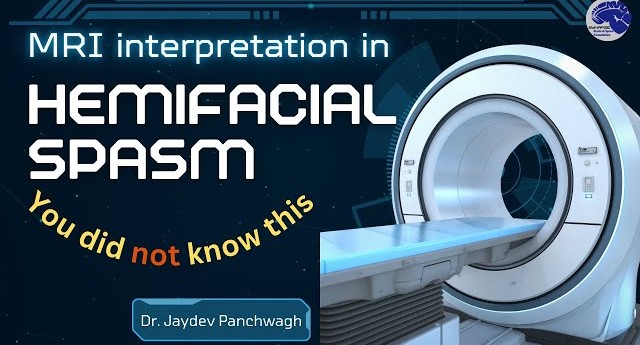Hemifacial Spasm & MRI Confusion: What the Neurosurgeon Actually Says

Many patients today read their MRI reports closely and often get confused when they see neurovascular conflict (NVC) on both sides of the face — even though they’re experiencing spasms only on one side.
Dr. Jaydev Panchawagh addresses this frequently asked concern in his talk. Here’s a detailed breakdown of what he says, straight from the transcript:
Can You Trust the MRI Report?
MRI findings can often be misleading. It is very imp to consider who reported the MRI.
- Most radiologists do not specialize in reporting neurovascular conflict.
- Only a few experienced radiologists go deep into this and even watch surgical videos to understand real compression.
- That’s why the doctor says — he doesn’t fully trust most MRI reports when it comes to hemifacial spasm.
Why Do Spasms Occur Only on One Side Even When MRI Shows Vessels on Both?
Two essential conditions must be met for a hemifacial spasm to occur:
- The blood vessel must be in a specific position — a sharp curve that causes pulsatile pressure on the nerve.
- The facial nerve must be sensitive — this sensitivity is congenital (since birth). The root entry zone (REZ) of the nerve must be poorly formed, making it naturally vulnerable.
So even if there’s a blood vessel on both sides, only the side where the nerve is sensitive will show spasms. On the other side, the nerve may have formed normally and isn’t vulnerable — hence, no spasm.
What If MRI Shows No Blood Vessel at All?
If there are no visible vessels on the MRI, Dr. Panchawagh advises:
- First, check who reported the MRI — a general radiologist or a neurosurgeon?
- If needed, repeat the MRI with angiography and 3D reconstruction.
- Still no vessel? Then, review the patient’s neurological history in depth.
What Medical History Should Be Checked?
In all patients with hemifacial spasm, the following conditions should be ruled out:
- Multiple Sclerosis (MS)
- Bell’s Palsy
- Demyelinating or degenerative nervous system disorders
Sometimes patients forget they had Bell’s Palsy years ago — and only remember it when asked again.
The doctor shared that in the past 20 years, there has been only one case where no compressing vessel was found during surgery. That patient had multiple sclerosis, which she forgot to disclose earlier despite being asked.
Final Word from Dr. Jaydev Panchwagh
MRI is only an indicator, not a final decision-maker.
Written by:
Dr. Jaydev Panchwagh
Neurosurgeon, M.Ch. in Neurosurgery

A distinguished Brain and Spine Surgeon, shaping neurosurgical care in Pune, Maharashtra, India for over two decades.
Quick Link

Quick Contacts
- Phone : (+91) 9011333841 , (+91) 7720948948
- brainspine66@gmail.com
- 102, Bhagyatara Society, 1st floor, Mehendale Garage road, Erandwane, Pune
Map
- Copyright @2025 | Dr. Jaydev Panchwagh | Praavi Medicare

Leave a Reply